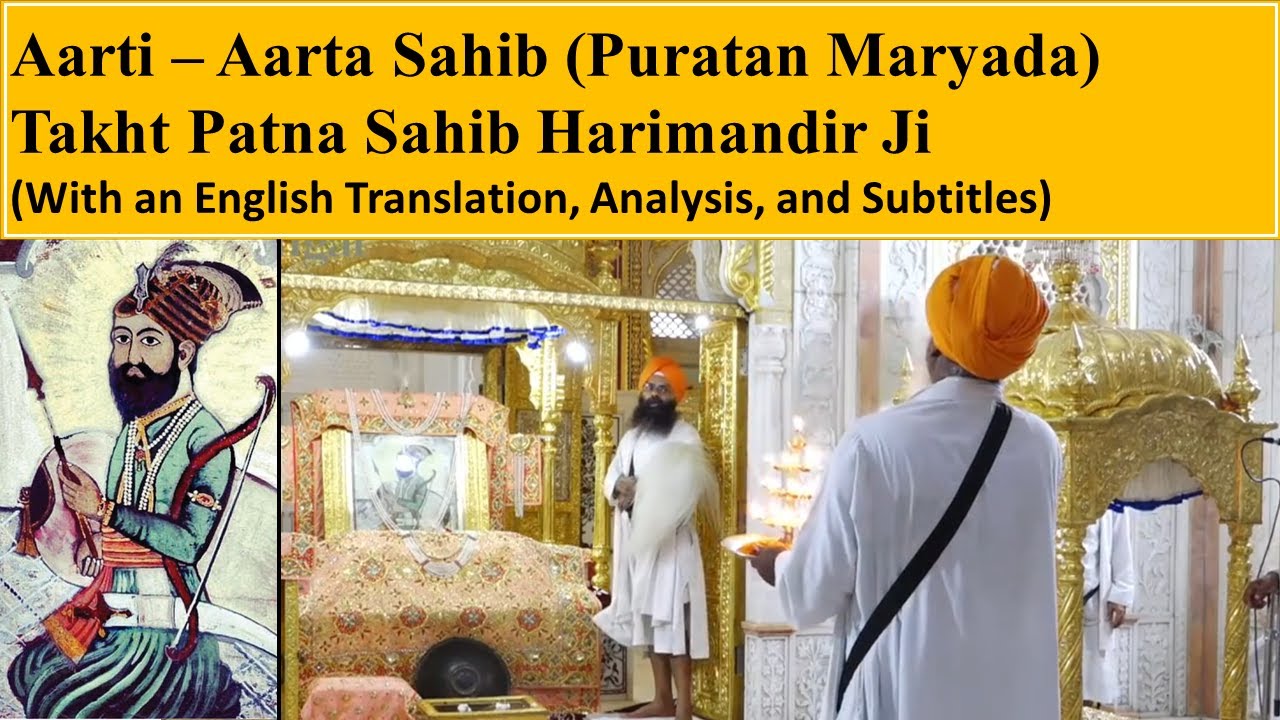This video was uploaded on Feb 9, 2022.
Puratan Aarti – Aarta Maryada at Takht Sri Harimandir Ji Patna Sahib (Takht Patna Sahib). This video was made for the purposes of research and looking more closely at the Puratan Maryada of Takht Patna Sahib.
Around the time when the Sikh Misls were rising in Punjab (before Maharaja Ranjit Singh’s time), the British East India Company was starting to establish control around Patna. Around March 1781, Sir Charles Wilkins, visited Patna Sahib en route to Benares (Varanasi) and noted seeing amongst other things, “arid pictures of Mussulman Princes, and Hindoo Deities” inside the “Seek College”.
(see Page 288, for his full account published in this 1806 book: https://books.google.ca/books?id=Xv0IAAAAQAAJ&dq=The+Seeks+And+Their+College+At+Patna+-+Sir+Charles+Wilkins+(1781+AD)&source=gbs_navlinks_s )
A “Mussulman prince” could be an assumption he made from viewing the particular painting of Guru Sahib preserved at the Takht Sahib. In 1781, memories of Guru Gobind Singh Ji still would’ve been fresh, as Guru Sahib had only left the mortal world 73 years prior to this. For comparison’s sake, the partition of the subcontinent happened around 75 years ago (as of 2022), & marathon runner Fauja Singh (born 1911) & Dr. Manmohan Singh (born 1932) lived through that time. Indeed, its entirely possible that during 1781 CE there were still some Sikhs, who witnessed Guru Gobind Singh Ji’s time.
Bhai Desa Singh Ji’s Rehatnama (believed to be written in the late 1700s) further describes the importance of Amritsar, Anandpur Sahib, Patna Sahib and Abachal Nagar (Hazur Sahib) for the Khalsa.
Charles Wilkins’ rare account also provides us with insights into what changed and what hasn’t.
Even today, Patna Sahib preserves many original practices of the Khalsa, such as Aarti-Aarta. An interesting source (Mukat Marg Granth) on the Aarti Maryada would be shown soon in a future video.
Aarti-Aarta at Takht Patna Sahib consists of:
00:07 Gagan Mai Thaal* (Baba Nanak Ji – Ang 13)
02:18 Namu Tero Aarti Majanu Murari (Bhagat Ravidas Ji – Ang 694)
04:31 Dhup Deep Ghrit Saaji Aarti (Bhagat Sain Ji – Ang 695)
05:45 Sun Sandhiya Teree Dev Devaakar (Bhagat Ram Kabir Ji – Ang 1350)
07:34 Gopal Tera Aarta (Bhagat Dhanna Ji – Ang 695)
(^^^ From Guru Granth Sahib Ji)
08:36 Sawaya: Shankan Ki Dhun (Guru Gobind Singh Ji – Panna 75)
09:20 Dohra: Aaise Chand Partap Te (Guru Gobind Singh Ji – Panna 75)
09:32 Chatr Chakravarti (Guru Gobind Singh Ji – Jaap Sahib – Panna 10)
(^^^ From Sri Dasam Granth Sahib Ji)
At 08:36, a Phoolan Kee Barkha (Rain of Flowers) accompanies the Sawaya.
- Takht Patna Sahib seems to use the Kirtan Sohila “Gagan Mai Thaal” Shabad (present on Ang 13) instead of the similar Aarti Shabad (on Ang 663) in Guru Granth Sahib Ji.
The Khalsa Dharam Shaster of 1914 CE, & Mukat Marag Granth from the 1700s, don’t specify exactly which “Gagan Mai Thaal” Shabad (Ang 13 or 663) is to be recited for Aarti. In the index of the Kartarpuri Bir of Guru Granth Sahib Ji, Kirtan Sohila is referred to as the “Sohila-Aarti Panch Shabad (5 Shabads of Sohila-Aarti)” (https://archive.org/details/SriKartarpuriBirDeDarshan/page/n13/mode/2up ). Takht Panta Sahib’s choice of the Ang 13 Shabad, could even be a legacy carried forward from the time of Guru Tegh Bahadur Ji.
During the time when Baba Sumer Singh Ji (1847-1903) served as Jathedar Sahib of Takht Patna Sahib, (see Photos and details by Sikh Researcher Bhai Jvala Singh: https://twitter.com/jvalaaa/status/1307441934357549057?lang=en ), an attempt to write the 1st all-Takht approved Sikh code of conduct was started by Bhai Avtar Singh Vahira. Baba Sumer Singh Ji, who was coming from the lineage of the Giania Bunga of Amritsar, also happened to be a descendant of Guru Amar Das Ji (the 3rd Guru Sahib). He was looking forward to the completion of the project but left his mortal frame before its completion. (https://twitter.com/jvalaaa/status/1309082888449732613?lang=en ).
The Maryada established at Takht Patna Sahib probably came from Amritsar, the same one which Bhai Mani Singh Ji (in the same lineage of Giana Bunga) established there during the time of Guru Gobind Singh Ji. Even today, the Rehras Sahib prayer of Takht Patna Sahib is similar to the former Harimandir Sahib/Akal Takht version (now being preserved by Damdami Taksal in Punjab). Even the Aarti was perhaps similar (if not the same), until the SGPC-era.
The Khalsa Dharam Shastar records the reading of the “Shankan Ki Dhun” Sawaya after the 4 [minimum] Aarti Shabads are completed. This offers some support to the theory that the “Shankan Ki Dhun” stanza must’ve been recited in Amritsar prior to the SGPC-era. Moreover, the text also describes how Aarti is supposed to be done with lamps while standing up. Sunder Singh Ji Ramgharia described the practice taking place like this in 1903 CE at Harimandir Sahib in Amritsar. The “Sikh Rehat Maryada” of 1936, unfortunately, ended up marginalizing this tradition/practice in Punjab.
Copying and publishing of the information shared on PuratanM.com and Traditional Dharmic Truth Seeker without permission, without proper citation, and/or without appropriate credit is a violation of copyright and an infringement of intellectual property.
